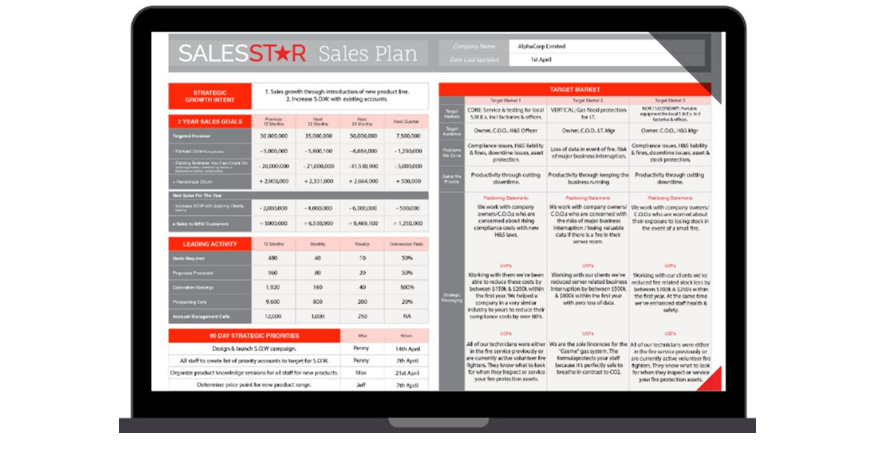Written by Sean McPheat | 

Creating an effective and realistic sales plan is a crucial process which aligns the work of your sales teams with the company’s overall objectives. It shapes and focuses the efforts of your sales executives, identifies key goals and targets, and tracks progress.
In this article, we’ll explore the essentials of sales planning, provide sales plan examples, and discuss how this document can help your business achieve its objectives. Additionally, we’ll guide you through how to write a sales plan effectively.
Contents

A sales plan is a document setting out the strategies, milestones, methods, responsibilities, and timeframes for achieving specified sales goals. It will describe your target markets and any potential obstacles your sales teams will encounter in pursuit of their goals.
It is a dynamic document which may be modified quarterly and annually, as market forces change. It generally covers a timeframe of no more than one year. A sales plan can be thought of as a subsidiary document to your Business Plan. The high-level objectives contained in your business plan are made concrete for your sales division by means of your sales plan.
Forbes recently warned that focusing exclusively on what’s been lacking, can prevent you for creating an effective sales plan. As they put it, “the best drivers are constantly looking ahead and behind, taking stock of their position and formulating a plan to efficiently reach their desired destination — and the most effective sales leaders are no different.”
Here are some of the things an effective sales plan can do for your business:
Your sales plan need not be a lengthy instrument – it is not an annual report or a corporate-level Business Plan. Instead, it is a practical document giving concrete targets, dates, and strategies to achieve key goals in alignment with corporate direction.
Harvard Business Review recommend making this a “nimble” plan rather than something set in stone and followed blindly. As they put it, “sales support teams forgo the project mindset, where planning cycles end with a finished plan. Instead, planning becomes an almost nonstop process.”

A sales plan is usually signed off by executives, but primarily it benefits the sales team by clarifying the activities that must be undertaken to achieve concrete goals. It is an essential document in that, without such a plan, sales will stagnate, dip, or fail to achieve reasonable returns. It also promotes a disciplined approach to sales, helping promote and project corporate responsibility.
In truth, any complex human activity involves planning, and sales should be no different, even if much of its success depends on the subtleties of interpersonal communication.
Constructing such a document (and adhering to it) will allow you to:
As you can see, it’s a wide-ranging document both in its scope and in terms of the potential benefits which can accrue. Inevitably, creating such a document is an involved process.
Now let’s break down the stages involved in constructing a sales plan, who needs to be consulted, and what its final shape will be.

Constructing a viable and functional sales plan will involve stakeholders both internal and external to your sales division. It is vital to align the plan with wider corporate objectives and strategy. Remember that the plan will have resource and budget implications, meaning that it may have to be signed off at executive or board level.
Here are the ten steps towards creating the perfect sales plan:
1: Analyse and Understand Your Corporate Strategy
First and foremost, you need to know how your sales plan will integrate with the company’s overall vision and direction. Is the company angling towards a younger demographic? Is it investing in R&D to expand its product line? Has the company just adopted a net zero target for carbon emissions? Are they moving to a hybrid working pattern?
All these considerations could affect your sales strategy, creating new priorities and new target customers. You’ll need a very different strategy if you’re pivoting towards Gen-Z consumers rather than millennials, for instance.
Talk to heads of department from related divisions – marketing, customer relations, research and development, and more. Read all the documentation you can and make sure you can write out, in a sentence or two, what your company’s mission objectives are for the coming years.
Your marketing division is especially important – they’re in a symbiotic relationship with sales, after all. Hopefully you’re in regular two-way dialogue on strategy already. If not, it’s time to strengthen those lines of communication.
If you know there are big changes ahead, it may make sense to construct your plan as a quarterly document, rather than an annual plan.
2: Audit your Current Sales Strategy
Either you have a pre-existing sales plan, or you don’t but the division has established ways of working. You’ll want to both read strategic documents and, probably more importantly, talk to sales team members.
You’ll want to get as complete a picture as possible, so it makes sense to talk to both junior sales reps and managers and encourage honesty and transparency. An anonymous survey might be a good way to obtain comparable data on how sales executives feel they are doing. Focus groups could also be useful, so long as everyone know they are free to speak openly and honestly.
What you’re looking for are the pain points potential customers reveal, as well as the things they especially love about your brand. Pain points translate to obstacles to overcome, and compliments become key selling points.
Another important component of such an audit is the sales data. Hopefully you’ll have access to data analytics to help compare targets to revenue achieved. Trends should become apparent, such as times of the year when your sales department lags a little.
Finally, you’ll want to look at your budget – how it was allocated and whether it produced a good ROI or not.
3: Talk to Your Customers
This is an often-neglected resource and it’s a great shame. Moreso than ever before, consumers are happy to feedback on the service they received, particularly if they feel invested in your product. Collaborate with marketing and your CRM staff to create user surveys and focus groups.
You can also apply AI-derived analytics, including sentiment analysis to find out what customers are saying about your products and services. There are a range of algorithmic tools on the market which can delve into social media posts for brand mentions, or review sites for star ratings and comments.
Hopefully you’ll glean some invaluable insights into what users like or don’t like about your products. You’ll be able to feed this back to R&D and use it to inform what aspects of your product offering your reps will highlight (or gloss over!)
4: Survey the Current Marketplace
Four steps in and we’re still on research? That’s right – constructing a sales plan isn’t a straightforward process. At least, it isn’t if you want to create a Plan that succeeds.
The final piece of the research jigsaw is to audit the marketplace for your product, which means looking at industry statistics and competitor intelligence (CI). Like audience information, CI can be sought using AI-driven algorithmic tools. You’re looking for new product releases, reviews, and customer feedback on public forums.
You both learn from your competitor’s mistakes, and their big successes. What you crucially learn, however, is what your product or service offers which is distinct. From this you can derive the USPs that will inform your sales scripts.
5: Define your Key Objectives and Targets
Now that you have all the information to hand, you need to begin with the top-level mission statement. What are your primary objectives? Here are some examples of reasonable sales objectives:
Hopefully, what you’ll notice about the above objectives, is that they all comply with the classic SMART method criteria, namely being:
The fourth item, realistic, may be hard to gauge, particularly if you’re going to be selling a new product or bringing new employees into the fold. That’s okay – this is why the sales plan is a dynamic document, subject to later revision if reality doesn’t align with your aspirations.
You’ll want to set targets for each subdivision of your sales department, perhaps for each product line or brand. You may find you get better results if you don’t set the same targets for all sales reps, but instead set averages across teams. Experienced executives might reasonably be expected to perform better than rookies.
However, it’s up to your sales leads to determine what sort of approach to promote in terms of direct competition between reps. This will probably be determined by your corporate culture at large.
6: Determine Success Metrics
Now you need to decide what you’ll measure to determine success against your set targets. Questions you’ll need to ask will include:
Sales reps are highly motivated by targets, so it’s clearly important to set the right ones, and ensure you have a means of monitoring them. Many sales platforms include auto-generated metrics, dashboards, and reports which you can circulate. You need to specify in your plan which metrics you’ll measure, how often you’ll report back, and to whom.
There are a lot of potential metrics to choose from. Here are just a few you might consider:
You may choose several of the above metrics to measure, or all of them, but it’s important not to set too many targets for sales reps to achieve. As ever, there’s a fine line between motivation and migraine-inducing pressure.
7: Identify Resources Required and Allocate Budget
Although detailed financial planning may remain with corporate accounting, top level budget line items need to be specified. To do that, you’ll need to identify what resources your sales team will need, and what proportion of your budget to allocate towards each one.
Expenditure to consider might include:
This is not an exhaustive list, but it’s important to decide how much to allocate towards onboarding, salaries, and lead generation.
If you’re selling a new product, expanding into a new territory or chasing down a new demographic, your budget may require additional line items for research resources to develop effective strategies.
8: Finalise Strategies, in Consultation with Sales Leads.
Now you know your targets, market, budget, and schedule, you can begin to devise specific strategies, in collaboration with sales leads. You can then divide up human resources according to the most sensible use of your budget.
You’ll want to start big picture, then fill in the detail once your plan is coming together. Some types of strategy you might consider include:
These are just a few of the most common strategies. It may be that you allow a degree of flexibility with regards to which reps use which techniques. It can often be a good idea not to become too prescriptive within your plan about the specific methodology used to obtain projected sales.
9: Playbook and Script Creation
Before the final plan is drawn up, sent out for consultation, edited, signed-off, and made public within your organisation, you’ll need some other materials in place before you can go live.
Playbooks and sales scripts are the two main tools to consider. Here are brief definitions of both terms:
Playbooks are detailed sets of actions to be performed to formalise the sales process. They consist of the mandatory actions you’ll want all reps to undertake. The main purpose of a playbook is to ensure consistency within the team, as well as making sure nothing vital is forgotten. Sometimes these are presented as lists of nested bullet points; in other instances, a simple flowchart might suffice.
Sales Scripts, as the names suggests, are written examples of how a typical sales conversation might go including the type of sales questions you might ask and how to overcome objections. These are often presented as flowcharts, telling reps what to do when a lead responds with a particular pain point.
How prescriptive you are will depend, again, on corporate culture. However, it pays to build in room for flexibility, and for each rep to improvise a little. How a rep might build upon a set script will depend upon their personality, and sometimes an innovation will be made which is worth adding to the next iteration of the script. This one reason why it pays to listen to your recorded sales calls periodically.
There are creative tools to help you devise and maintain playbooks, and even AI assistants to help you with prompts during sales calls (such as offering up prices and calculating discounts). These might be worth looking into and adding to your resources budget.
10: Writing Up your Sales Plan
After going through this process, you’re at last ready to compose and finalise your sales plan. However, like any written document, getting this last stage right means following a set of sub-steps:
This may seem like a lot but provided you haven’t created a 400-page epic, you ought to be able to turn the document round in a matter of weeks.
You’ll then need to enlist assistance to make physical print copies (which you should always have to hand) and to put the document online via your intranet, ideally with a table of contents so that reps can jump straight to the section they need.
Congratulations if you’ve survived this process! It’s been challenging, but you should finally have a working document that gives real direction to your sales division.

Let’s breakdown what constitutes a well-written sales plan. This can differ in terms of headers and running order, but broadly speaking, all the following elements should be included.
Target Customers (Leads)
Here you’ll specify your typical customers. Customer personas or avatars are often useful here – written and illustrated guides to the kind of individuals you’re looking to convert to customers.
You might start by breaking down who your current customers are, giving demographic information such as age, gender, location, typical salary, likes and dislikes. You can also describe the types of problems they face which your product should solve.
If your research has identified an opportunity gap, such as an underserved sector, you may go on to describe the type of customer you are pivoting towards. This section might specify what proportion of contacts should target new business within this demographic, as opposed to tried and trusted typical customers, which you’ll also seek to retain.
Revenue or Acquisition Targets
Here you’ll get concrete about the targets you’re setting each team and each rep. This might be described in financial sums, or if you’re acquiring new business, in numbers of conversions. Alternatively, it might be a combination of both, i.e.:
As with overall corporate targets, the goals you give your teams and your individual reps need to be SMART, so that both the reps and their line managers can measure performance against something concrete.
Pricing, Discount Limits and Promotions
You need to give clear guidelines as to what price range your reps can work within. As well as standard price ranges, the plan must keep them up to date with any promotions you’re running, and any discounts they can offer.
If you’re using dynamic pricing, then the sales plan needs to be able to reflect changes in real time, perhaps automating price range descriptions so that costly mistakes can be avoided.
Sales Tactics
Here’s where your playbook and scripts come into play, guiding your team towards appropriate and proven strategies. You’ll want to ringfence allowable and non-allowable tactics, particularly where it’s important to your brand identity.
Your playbook or sales platform may help here – guiding reps to the potential techniques they can use at any given moment, such as offering a discount or setting an appointment for a free product demonstration and what to include in your sales pitch. What can and can’t your team negotiate with?
Deadlines and Lines of Reporting
Clearly, it’s important to give concrete dates for the achievement of stated milestones, whether these are specific dates or “per quarter” indications.
It’s also important to clarify who takes ownership of the sales plan, its monitoring and accountability for results. The Plan should specify to whom reports are given, and how frequently.
If there has been significant onboarding during the formulation of the plan, then it’s worthwhile drawing up a new departmental organisation chart, showing lines of reporting across teams, regions (if extant) and the sales division overall.
Sales Team Structure
Related to the lines of reporting, you might include a diagram of sales team structure – how many reps, sales managers, division heads, sales directors and how the teams are comprised. This should include lines of communication with other departments, such as customer relations, product development and marketing.
Resources
Here’s where your Plan outlines your tech stack, primarily, as well as any hardware your sales team may be given to carry out their roles. Typical resources you may list might include:
Again, this is not an exhaustive list and new tools are coming onstream constantly. There are AI-driven research and even writing resources, for instance, which could be worth investigating. It may be helpful to specify who is responsible for assessing and upgrading your tech stack, and how frequently resources will be revised.
Market Conditions and Competitors
This is a section that will need to be revisited regularly. It’s useful to give a summary of where the brand sits amongst its chief competitors and what conditions are like within the market. Among the considerations you might describe are:
Once again, this is not an exhaustive list, and you should be careful not to overwhelm the reader with information. It may be helpful to use graphics to powerfully represent key information, particularly if it provides additional motivation (and to limit the stultifying effect of too much data).

Here we’ll present a sample structure of a sales plan. You may choose to order yours differently, but these are the mandatory elements of an effective plan.
1: Mission and Context
Begin by outlining the process that led to the creation of the sales plan. From the decision that inspired its genesis to the research that went into its creation and its ultimate purpose. Summarise the journey. This helps build ownership and clarify the importance of the document and how useful it will be.
2: Team and Responsibilities
Here describe the key stakeholders – who will be responsible for the Plan being enacted, and for targets being hit. You might for example list your sales team members, any sales enablement partners and external research professionals.
If you have a small to medium-sized business you could include short biographies, contact details and photos to help personalize the document and promote team cohesion.
3: Market and Buyer Personas
Here you outline which market segment your brand inhabits, and which products you will target towards which demographics. You can include buyer personas, which are short biographies of fictional “typical” customers, helping your sales team identify the kind of customers they need to target.
These personas will likely change as your brand develops. As a start-up, you are unlikely to be selling to the same customers as those you can attract when you are the brand leader. This section will need to be revisited as sales trends change.
4: Tech Stack and Resources
Here list the tools your staff will need to use or will have at their disposal as optional resources. There will be an onboarding implication, so make sure you specify which tools will be mandatory and what training will be provided.
You can breakdown your resource provision into:
5: Market Positioning
You can identify where your brand lies within the overall sector landscape. For instance, you may specify what segment of the market your product or services will address, and whether you are offering a premium or budget product.
Who are your chief competitors and how is your product offering different from theirs? You can outline some of the USPs you’d like your sales teams to focus on in this section too.
6: Prospecting and Sales Strategy
Here you can outline the approach you’d like your sales team to take, including any specific pricing strategies, discounts, bundle offers or other sweeteners.
You can describe how you’ll address potential customers at various stages of the sales pipeline, from cold leads, to qualified leads, to conversions, to retained or repeat customers.
7: Targets and Goals
Now you’ll get more granular, outlining specific goals (remember to keep them SMART) and targets for each defined period (monthly, quarterly, annual, long-term). Some plans outline short-term, medium-term, and long-term goals and this approach will make more sense if you are devising an annual sales plan.
As described above, be as concrete as possible with goals, i.e.:
Achieve £100,000 sales to over 1500 new clients by 31st March 2023.
8: Sales Budget
Here describe the main budget headers, as well as any known per-person expense allocations. As well as the obvious elements such as salaries and bonuses, don’t forget to include the following: travel, entertainment, training, team-building events, sales tool subscriptions, conference attendance, bonuses, and competition prizes.
Learn what a sales budget is and how to prepare one.
9: Closing Statement
It’s good to end with a motivational quote or two, or a well-written piece by your CEO or Head of Sales, to end on a high note and make readers feel they’re embarking on a meaningful and rewarding challenge.

Here are just four contrasting sales plans, from a variety of planning platforms and sales coaching providers, which fulfil the above brief. You’ll see that they don’t need to be overlong, and that not all of them contain everything listed above.
1: Venngage’s Online Sales Planner
Venngage takes a very graphical approach to sales planning, hosting a suite of templates which plot out your sales plan in the form of a chart or wall planner.
Sales are divided into divisions (online, in-store, wholesale) and then charted in columns including products and services, costs, projected sales, strategy, deadline and KPIs.
This would be a good approach for a top sheet, with the full sales plan adding more detail within each division. An online version might let you click on each section for a more in-depth view.
2: 30-60-90 Day Sales Plan from Template.net
This is a more traditional, report-based sales plan, which begins with top level objectives, then goes on to outline the sales team (including headshots) and then provides an action plan across three timeframes.
Given its comparatively short overall timeframe (quarterly), this plan would need to be updated regularly, and it would make sense to add a section which summarizes the effectiveness of the previous quarters. This would help ground any changes that subsequent iterations make to the plan.
3: TemplateLab’s One Page Sales Plans
There are a range of one-page sales plans on TemplateLab’s site, which could form the basis for more thorough documents. The format below is brief, but does contain room to indicate lines of responsibility, resources, and desired outcomes.
Again, this would be a top sheet, or a summary which each sales rep could keep pinned to their cubicle (or kept on their desktop).

4: SalesStar’s One Page Plan
UK-based Sales Coaching company SalesStar offer a free download of their one-page sales plan. Although it’s a one-pager, its surprisingly thorough, including space to indicate segregated target markets, pain points, USPs, strategies and concrete KPIs with deadlines.

Although there are a range of templates available online, there’s no substitute for creating your own document, which will allow you to specify everything your business and sales department need.
Indeed, creating the document will help walk you through the process of rethinking your sales operation. Creating a sales plan will inevitably lead to efficiency and cost savings, even if the process itself is labour intensive.
Please contact us for further information on our Sales Management Training and Account Management Training solutions.
If you’re a sales manager then please check out these 17 icebreakers you can use for your sales meetings. They’ll give you some great ideas.
If you’re ever looking for some Sales Training then please check out our Sales Training Courses. We offer a variety of face to face and Online Sales Training solutions.
Thanks
Sean

Sean McPheat
Managing Director
MTD Sales Training
Updated on: 4 March, 2022
Related Articles

Search For More
